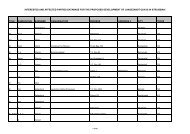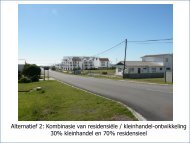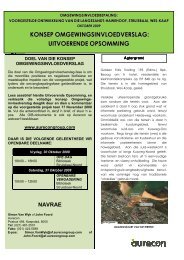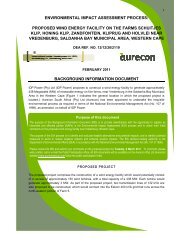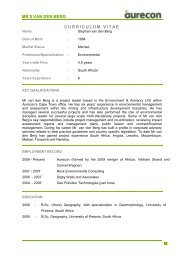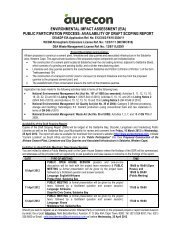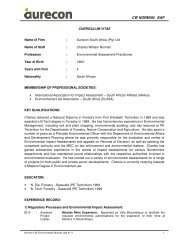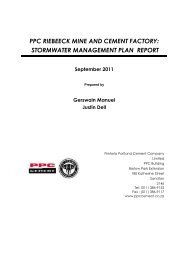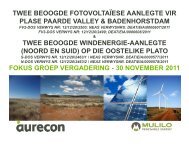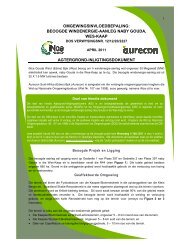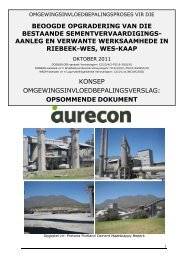Final EIAR - Aurecon AME Environmental | Environmental Projects
Final EIAR - Aurecon AME Environmental | Environmental Projects
Final EIAR - Aurecon AME Environmental | Environmental Projects
Create successful ePaper yourself
Turn your PDF publications into a flip-book with our unique Google optimized e-Paper software.
Proposed Wind and Solar (Photovoltaic) Energy Facilities on Kangnas Farm near Springbok in the Northern Cape: <strong>Final</strong> EIR 13<br />
• Site notices, in English and Afrikaans, were erected at the entrances to the farms and at<br />
the Springbok Public Library on 28 May 2012 (the site notices are included in the Scoping<br />
Report).<br />
1.4.2 The Scoping Phase<br />
Scoping is defined as a procedure for determining the extent of, and approach to, the EIA<br />
Report phase and involves the following key tasks:<br />
• Involvement of relevant authorities and I&APs;<br />
• Identification and selection of feasible alternatives to be taken through to the EIA Phase;<br />
• Identification of significant issues/impacts associated with each alternative to be<br />
examined in the EIA Report; and<br />
• Determination of specific Terms of Reference (ToR) for any specialist studies required in<br />
the EIA Report (Plan of Study for the EIA Report).<br />
The Scoping Phase involved a desktop review of relevant literature, including a review of<br />
previous environmental studies in the area. These included, inter alia, the following:<br />
• Namakwa District Municipality (DM) Integrated <strong>Environmental</strong> Management Program<br />
(IEMP)(African EPA, 2007);<br />
• Namakwa DM Spatial Development Framework (SDF) (2007);<br />
• Nama Khoi Local Municipality LM SDF (Macroplan, 2007);<br />
• Vegetation Map of South Africa (Mucina and Rutherford, 2006); and<br />
• Groundwater Resources in the Northern Cape Province (DWA, 2008).<br />
An inception field trip of the site was undertaken on 25 November 2011 to inform a Fatal Flaw<br />
Analysis (FFA) for Mainstream. The main purpose was to familiarize the consultants with the<br />
site and to allow for a rapid survey of the site to identify potential areas of concern. Valuable<br />
information was also obtained from landowners, who have intimate knowledge of the farms and<br />
general area.<br />
The information gathered during the site visit and subsequent report was used in refining the<br />
Plan of Study for the EIA process and ToR for the specialist studies which were undertaken<br />
during the EIA Phase.<br />
1.4.3 The EIA Phase<br />
The Scoping Phase is followed by the EIA Phase, during which the specialist investigations<br />
occur, and culminates in a comprehensive EIR documenting the outcome of the impact<br />
assessments.<br />
This report covers the third and final phase of the EIA process, namely the EIA Phase. The<br />
purpose of the EIR is to describe and assess the range of feasible alternatives identified during<br />
the Scoping process in terms of the potential environmental impacts identified. The ultimate<br />
purpose is to provide a basis for informed decision making, firstly by the applicant with respect<br />
to the option(s) they wish to pursue, and secondly by the environmental authority regarding the<br />
environmental acceptability of the applicant’s preferred option.<br />
© <strong>Aurecon</strong> (2012) No unauthorised reproduction, copy<br />
or adaptation, in whole or in part, may be made.<br />
P:\<strong>Projects</strong>\108495 Kangnas WEF & PV EIA's\3 Project Delivery\4 Reports\FEIR\FEIR 210213 <strong>Final</strong>.doc


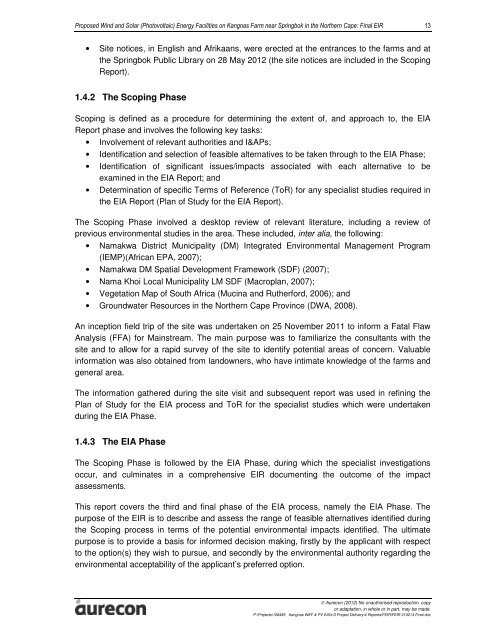
![CRR IV FEIR ~ 26042010 [FINAL].pdf - Environmental Projects](https://img.yumpu.com/21973020/1/184x260/crr-iv-feir-26042010-finalpdf-environmental-projects.jpg?quality=85)
